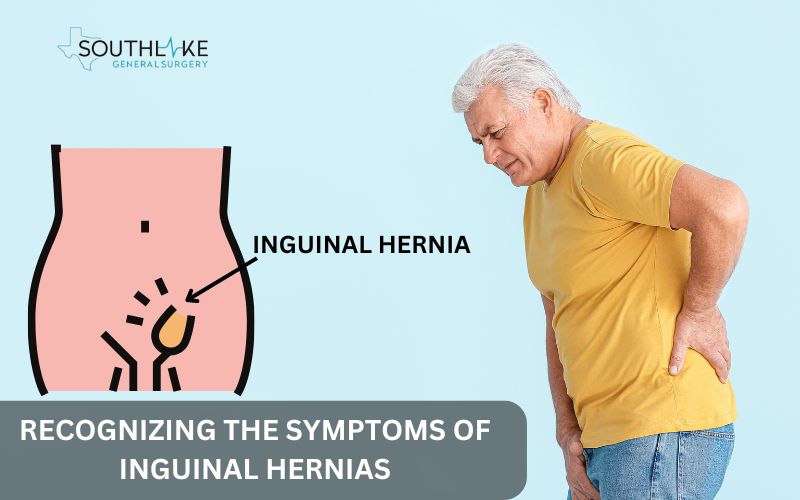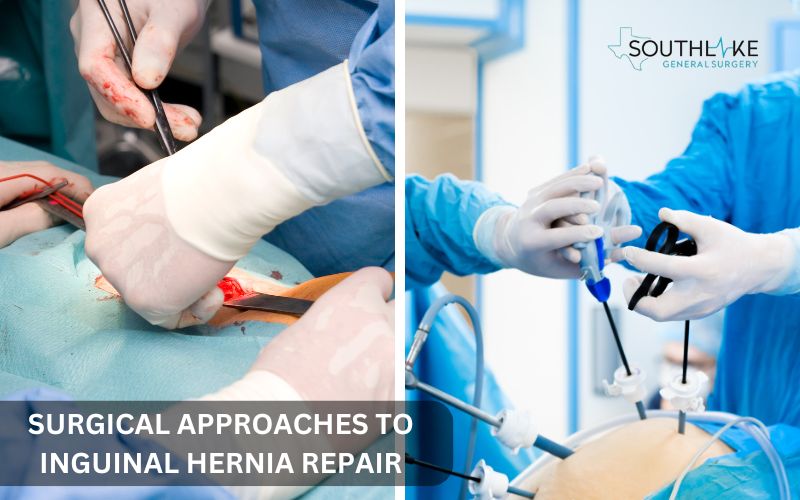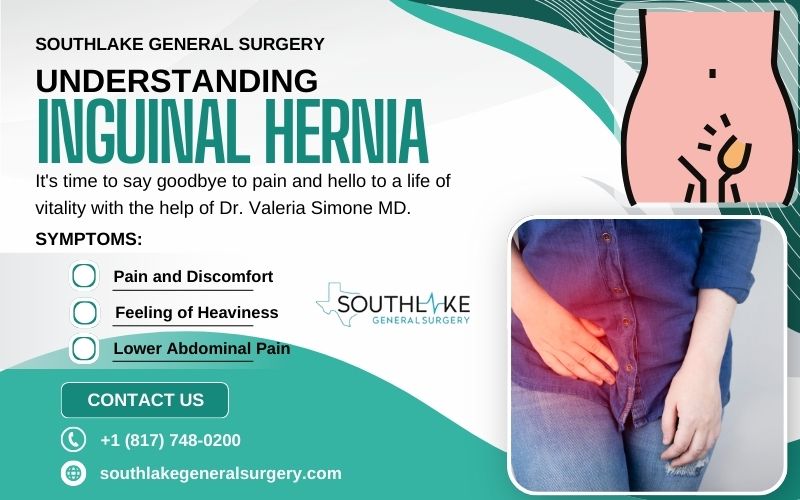An inguinal hernia, often referred to as a groin hernia, is a common condition that many people encounter. When a piece of fatty tissue or a length of intestine pushes through a hole in the abdominal wall, it’s called a hernia. This issue typically arises in the inguinal canal, which is found in the groin area.
Defining Inguinal Hernia
An inguinal hernia occurs when an area of abdominal fat or a section of the intestines pushes through a vulnerability in the abdominal wall of muscles. This usually occurs in the inguinal canal, which is in the groin area.
The inguinal canal plays a significant role as it contains blood vessels and nerves that are essential for various bodily functions. In men, it holds the spermatic cord, whereas in women, it contains the round ligament that helps support the uterus.
The abdominal wall consists of multiple layers. The layers contain muscles and tissues that play a crucial role in keeping your organs safely in place.
At times, a vulnerable area may develop within these layers. This frequently occurs in the inguinal canal. When that happens, it can lead to an inguinal hernia.
Types of Inguinal Hernias: Direct vs. Indirect
Direct inguinal hernias:
- Develop due to a weakness in the abdominal wall muscles, often arising gradually over time
- These typically happen in adults, with a higher prevalence in men, and are linked to the natural weakening of muscles that comes with age.
Indirect inguinal hernias:
- This occurs due to an existing opening in the inguinal canal, which is often present from birth.
- This condition is more frequently seen in infants, especially those born prematurely, but it can also impact adults, with men being more commonly affected.
Understanding the differences between direct and indirect inguinal hernias is helpful in grasping how they occur and the potential issues they can cause.
Direct hernias happen when the muscles in the abdominal wall become weaker, which can often be a result of aging or engaging in heavy activities.
Indirect hernias happen when there’s a birth defect that causes the inguinal canal not to close properly. This creates a weak spot that allows a hernia to develop.
Causes and Risk Factors
Inguinal hernias can happen for several different reasons. Certain individuals are born with conditions that increase their chances of developing hernias. As we age, the choices we make in our lifestyle, along with health concerns and the natural process of aging, can contribute to the development of hernias.
Previous abdominal surgery can lead to weak areas, which can contribute to this issue. All these factors come together to create this condition.
Understanding the Common Causes of Inguinal Hernias

- Heavy lifting: This can often lead to hernias, particularly if not executed with the proper technique.
- Constant coughing: This may lead to increased pressure in the abdomen.
- Straining too much during bowel movements: This can lead to a weakened abdominal wall.
- Being overweight: This may also lead to a weakening of the abdominal wall.
Identifying Risk Factors for Developing an Inguinal Hernia
It is possible that certain people are more prone to inguinal hernias than others. If a family member has experienced this issue, it may increase your likelihood of encountering it as well. This could be due to the genes that have been inherited from your family.
If you were born prematurely, had a low birth weight, or have experienced an inguinal hernia or related surgery in the past, you might have an increased risk.
Understanding these risk factors is valuable! If you have any concerns, it’s worthwhile to talk to a healthcare provider for early detection and support.
Symptoms and Detection
Inguinal hernias might not present clear signs initially. It’s important to notice both subtle indicators and obvious signals. This way, you’ll be able to get medical help promptly.
There are individuals who might not experience any symptoms whatsoever. An inguinal hernia can present various signs in different individuals. Understanding these signs is essential! This is particularly important if you have certain risk factors.
Recognizing the Symptoms of Inguinal Hernias

A noticeable bump in the groin area is the primary indication of an inguinal hernia. You might notice that this bump gets larger when you cough, lift something heavy, or put in some effort. This bump can also shift into the scrotum for men. Along with the bump, you might notice:
- Pain or discomfort
- An unpleasant feeling of heaviness or pressure in the groin area
- Pain that may extend to the lower abdomen or back
- Moving around could make the pain worse. Taking some time to rest often helps it to go away.
When to Seek Medical Advice for Suspected Hernia
Not every hernia requires immediate medical attention. If you see a bulge in the groin area, particularly if it’s causing any discomfort, it’s a good idea to reach out to a doctor for assistance.
The best way to avoid more serious problems in the future is to get regular checkups.
- If you notice that a hernia is causing more pain, feels tender, changes color, or becomes hard, it’s important to consult a doctor as soon as possible.
- These signs could indicate that you have a strangulated hernia. A strangulated hernia is an important medical condition that needs prompt attention and often requires emergency surgery.
How Inguinal Hernias are Diagnosed
Abdominal ultrasounds are diagnostic procedures that use sound waves to provide pictures of internal abdominal organs. The healthcare provider will inquire about the patient’s symptoms, lifestyle, and any existing health conditions they may have.
Next, a physical exam will be conducted. The healthcare provider softly examines the groin area. They sense its size, shape, and position. The provider will also look for any signs of pain.
The healthcare provider examines whether the hernia can be gently pushed back into the abdomen and looks for any signs of possible concerns.
- Your healthcare provider might suggest some extra tests, like an abdominal ultrasound.
- Abdominal ultrasound is a technique for creating pictures of the organs within the abdominal cavity by applying sound waves.
- This is useful for finding the hernia and verifying the diagnosis.
Role of Imaging in Confirming Hernia Presence

A routine physical exam should be enough to diagnose an inguinal hernia. Imaging tests like an abdominal ultrasound, CT scan, or MRI can provide a detailed view of the hernia and the surrounding areas.
These tests are helpful when the issue isn’t quite clear. This can frequently occur with patients who are overweight or if there are potential complications involved. The results from these tests assist doctors in determining the most effective treatment for the patient.
Treatment Options
The approach to treating inguinal hernias can differ depending on several factors. Among the elements to consider are the degree of the symptoms, the size, and the kind of hernia, the general patient’s condition, and the surgeon’s experience.
For many inguinal hernias, surgery is often seen to be the best option. This is particularly the case when they create challenges or may result in additional concerns. There are times when doctors consider non-surgical options too!
Surgical Approaches to Inguinal Hernia Repair

Surgery plays a crucial role in effectively treating inguinal hernias. This technique assists in gently repositioning the tissue back into the abdominal cavity. The weak abdominal wall can be strengthened with this surgery. There are two primary methods to perform this procedure:
- Open surgery: In a groin operation, a surgeon makes a single large incision. This allows them to see the hernia up close and repair it using surgical mesh.
- Minimally invasive surgery: For this option, the surgeon makes a few small incisions. The procedure may involve the use of a camera or robotic systems.
Specialized instruments and techniques are used during minimally invasive surgery. They usually lead to less pain after surgery and may help in a quicker recovery. While compared to open surgery, the scars from these procedures are typically less noticeable.
The decision between these two types of surgery completely depends on the unique circumstances of each individual.
Non-Surgical Management and Its Effectiveness
In certain situations, it’s possible to manage a hernia without the need for surgery. Here are some options to consider:
- Watchful waiting: Keeping a close eye on the hernia to see if there are any changes in its size or any new symptoms that may arise. This approach is ideal for small hernias that aren’t causing any symptoms and are unlikely to lead to complications.
- Lifestyle changes: This includes reducing factors that create pressure on the abdomen, maintaining a healthy weight, and managing constipation effectively.
- Managing symptoms: Using pain relievers, cold packs, and support garments can really help you feel better and enhance your daily life. It is important to note that these options won’t actually fix the hernia; they are designed to help manage the symptoms instead.
Recovery and Management Post-Surgery
Inguinal hernia surgery is a reliable and safe procedure that has proven to be effective. Following surgery, it’s important for patients to take the time they need to heal and to adhere to their doctor’s recommendations.
Knowing what to expect during your recovery can really help reduce anxiety and make everything go more smoothly.
After surgery, patients will slowly start doing the things they normally do in the days and weeks after the procedure. As they recover, they’ll start to feel more prepared to engage in various activities.
Open communication with medical professionals is crucial. This approach allows us to tackle any concerns that may arise. It also helps in healing and lowers the possibility of issues arising.
What to Expect During the Recovery Period
After inguinal hernia surgery, it’s common for patients to experience some pain, swelling, and discomfort in the groin area. The surgeon will provide pain medication to assist with these sensations.
Following the surgeon’s instructions on wound care, activities to avoid, and medication timing is important for a smooth recovery.
The length of time required for recovery after surgery can differ from one procedure to another. Patients who undergo minimally invasive surgery typically experience a faster healing process.
It’s ideal to begin with light activities whenever they feel ready! Following that, they can slowly increase their activities based on their surgeon’s advice.
Tips for Smooth Recovery and Preventing Recurrence

Encouraging a positive recovery and reducing the probability of hernia recurrence involves engaging in some beneficial practices. Here are some helpful tips for a smooth recovery and to prevent it from returning:
- Make sure to engage in regular exercise that your doctor has approved. This is a great way to help strengthen your abdominal muscles and provide support to the area that was repaired.
- Keep a healthy weight by enjoying balanced meals and staying active through exercise. This could be beneficial in reducing the strain on the abdominal wall.
- Learn the proper form of lifting by engaging your legs rather than your back.
- Do not lift anything heavy for at least a few weeks following surgery.
- A speedier recovery is possible if you follow these guidelines.
- You can lessen your chance of experiencing a hernia recurrence by doing this.
Conclusion
For a successful recovery after inguinal hernia surgery, it is essential to communicate clearly with your healthcare providers. Medications can alleviate swelling and pain in the groin region that patients may feel.
For a successful recovery, be sure to adhere to your surgeon’s recommendations about wound care, activity restrictions, and medication. The time it takes to recover can differ depending on the type of surgery, and generally, minimally invasive procedures tend to promote quicker healing.
To help avoid future hernias, it’s important for patients to stick to post-op care guidelines, participate in recommended exercises to strengthen their abdominal muscles, keep a healthy weight, and practice proper lifting techniques.
Make an Appointment
Are you experiencing symptoms of an inguinal hernia? Are you looking for expert surgical assistance for this issue? At Southlake General Surgery, we offer comprehensive diagnosis, treatment, and post-surgery care for all types of hernias, including inguinal hernias.
Dr. Valeria Simone, MD, our board-certified general surgeon, focuses on providing care that is both welcoming and centered around the needs of her patients. Feel free to ask for our assistance in making the right decisions!
Take control of your health. Don’t let hernia symptoms run your life. Contact Southlake General Surgery today at +1 (817) 748-0200, to set up an appointment with our expert surgeons. We are here to help you feel better and enjoy life without hernias!
Frequently Asked Questions
Can Diet Affect the Recovery from an Inguinal Hernia Surgery?
A nutritious diet that includes sufficient protein, vitamins, and minerals supports your body’s healing process and helps in building abdominal muscles. This type of diet can really support your recovery process!
Can one safely live with an inguinal hernia?
Symptoms may not be noticeable in cases of minor inguinal hernias. In such situations, you can observe them closely. Leaving one for too long, though, is usually not a good idea. This is because progressive symptoms can worsen and produce further issues. On rare occasions, emergency surgery can be required.
What should you avoid with an inguinal hernia?
Avoid these activities if you have an inguinal hernia:
- Lifting heavy things
- Excessive straining while using the restroom
- Anything that increases the strain on the abdominal region
These activities might aggravate hernia symptoms. They can also increase the possibility of complications. Getting medical help quickly is essential for the right check-up and treatment.
What alternative treatments or remedies exist for managing an inguinal hernia apart from surgical options?
The main approach to treating an inguinal hernia is through surgery. Alternatives that do not involve surgical procedures are also available. There are options available for you to consider, such as adjusting your lifestyle or utilizing support garments for managing the hernia. If the hernia is small and does not cause any issues, you might think about simply keeping an eye on it. These methods can assist in alleviating symptoms and enhancing your comfort. However, they don’t address the hernia itself.
Medically Reviewed By: Dr. Valeria Simone MD
Board-certified General Surgeon at Southlake General Surgery, Texas, USA.
Follow us on Facebook and YouTube.
References:
- “Inguinal hernia.” Current Problems in Surgery, vol. 28, no. 6, June 1991, pp. 407–50. https://doi.org/10.1016/0011-3840(91)90028-n.
- “Inguinal hernia.” National Institute of Diabetes and Digestive and Kidney Diseases, 9 Dec. 2021, www.niddk.nih.gov/health-information/digestive-diseases/inguinal-hernia.
- “Inguinal Hernia.” StatPearls – NCBI Bookshelf, 8 Aug. 2023, www.ncbi.nlm.nih.gov/books/NBK513332.
- “Inguinal Hernias: Diagnosis and Management.” AAFP, 15 June 2013, www.aafp.org/pubs/afp/issues/2013/0615/p844.html/1000.
- “Inguinal hernia repair”. medlineplus.gov/ency/article/007406.htm.( https://medlineplus.gov/ency/article/007406.htm)

